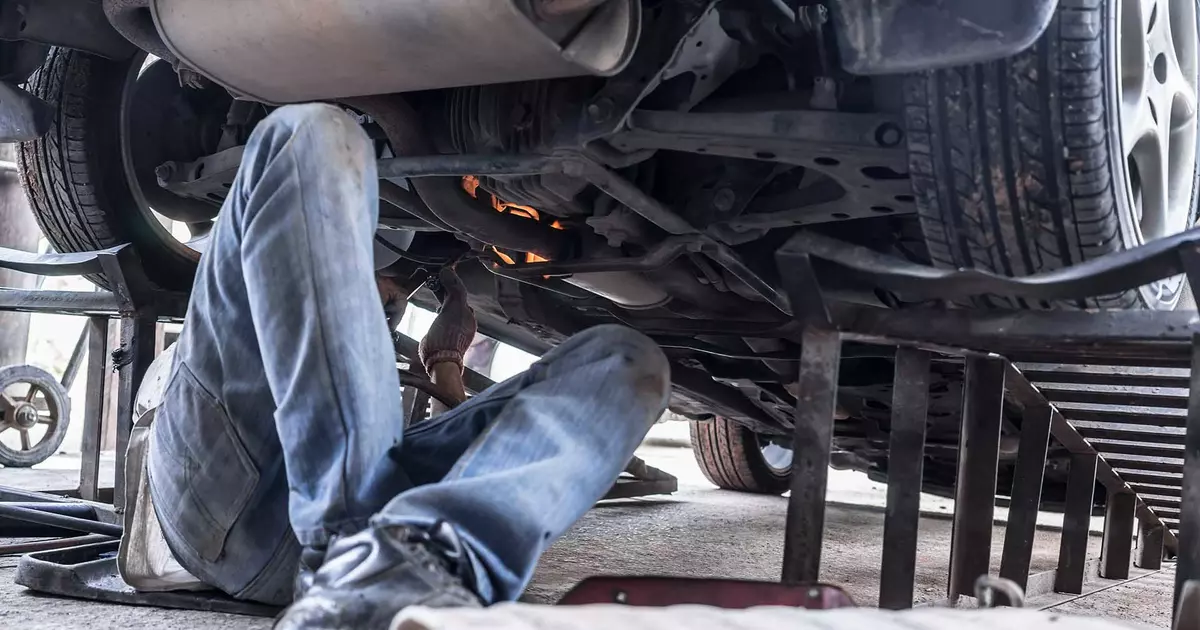Are car ramps dangerous? It’s a question you might ask yourself, especially if you’re planning to do some DIY car maintenance.
You want to ensure your safety while working under your vehicle, but doubts linger about whether car ramps are the right tool for the job. Imagine the peace of mind you could have knowing you’re using a safe method to lift your car.
But what if there’s more to the story? What if these seemingly simple tools hold hidden risks that could jeopardize your safety? You’ll discover the truth about car ramps. We’ll unravel the mysteries and dispel the myths, giving you the confidence to make informed decisions. By understanding both the benefits and potential dangers, you can protect yourself and your vehicle. Get ready to learn what the experts have to say and find out how you can enjoy safe and efficient car maintenance. Don’t let uncertainty hold you back—read on to uncover the facts that could make all the difference.

Credit: www.reddit.com
Understanding Car Ramps
Car ramps can pose risks if used improperly. Ensuring they are stable and correctly positioned is crucial for safety. Regular checks and proper maintenance help minimize dangers while enhancing efficiency in vehicle repairs.
Understanding car ramps is essential for anyone who dabbles in DIY car maintenance. Whether you’re changing the oil, checking brake pads, or just want a closer look at the undercarriage, car ramps can be a helpful tool. But if you’re not careful, they can also pose risks. Have you ever had a heart-stopping moment when your car seemed less stable than you’d like? It’s crucial to know how to use car ramps safely.Purpose And Uses
Car ramps are designed to elevate your vehicle safely. They provide better access to the undercarriage for various tasks. From oil changes to exhaust system checks, ramps make reaching these areas easier. Ramps also offer a safer alternative to jacks in some situations. Unlike jacks, which can be unstable, ramps provide a solid base. This stability is especially useful if you’re working alone. However, it’s important to ensure that the ramps are on a flat, stable surface. Uneven ground can make ramps dangerous. Always double-check that your vehicle is secure before getting underneath.Types Of Car Ramps
There are several types of car ramps available. Each serves different needs and vehicle types. Plastic ramps are lightweight and easy to store. They’re great for small cars and quick jobs. Steel ramps, on the other hand, offer more durability. They’re ideal for heavier vehicles like trucks and SUVs. But be mindful—they can be cumbersome to move around. Some ramps even have built-in features like wheel stops or extended platforms. These extras can make using ramps safer and more convenient. Do you know which type would best suit your vehicle? Before you purchase, consider the weight capacity and incline angle of the ramp. This ensures compatibility with your vehicle. A little research can go a long way in keeping you safe. In the end, understanding and choosing the right car ramp can make your maintenance tasks easier and safer. Make informed decisions, and you’ll have one less thing to worry about.Potential Hazards Of Car Ramps
Car ramps can be dangerous if not used correctly. Poor stability or uneven surfaces may lead to accidents. Always ensure ramps are on solid ground and secured.
Car ramps are a staple in many garages, offering a convenient way to elevate vehicles for maintenance. However, it’s crucial to be aware of the potential hazards that come with their use. Understanding these risks can help ensure your safety and the safety of your vehicle.Slippage And Stability Issues
Car ramps can be unstable if not used correctly. A slight misalignment can cause the ramp to shift, leading to dangerous situations. Always check the surface—smooth concrete is ideal to prevent slipping. Rubber mats can also enhance stability. Have you ever felt that unsettling wobble when driving up a ramp? It’s a sign that the ramp isn’t as stable as it should be.Weight Capacity Concerns
Every car ramp has a weight limit. Exceeding this can lead to structural failure. Imagine driving your car onto a ramp only to hear it crack under the weight. That’s a scenario you want to avoid. Always check the maximum weight your ramps can handle. Consider both the vehicle’s weight and any extra load, like tools or equipment.Improper Positioning Risks
Positioning ramps correctly is vital. Misalignment can lead to the car rolling back or slipping off. Have you ever parked on an incline and felt the car start to roll? Ramps can have the same effect if not positioned properly. Ensure the ramps are directly in line with your tires. Double-checking this simple step can prevent accidents.Safety Tips For Using Car Ramps
Car ramps can be dangerous without proper precautions. Ensure stability by placing ramps on flat surfaces. Always check your vehicle’s position before climbing underneath.
Using car ramps can be a practical solution for DIY mechanics or car enthusiasts looking to perform maintenance tasks at home. However, safety is paramount when lifting heavy vehicles. By taking a few essential precautions, you can ensure that your car repair sessions are both productive and safe. Let’s delve into some crucial safety tips that will help you use car ramps more effectively.Choosing The Right Ramp
Select a ramp that matches your vehicle’s weight and size specifications. Check the weight capacity label on the ramp to ensure it can support your car. A mismatch can lead to serious accidents. If you’re unsure, consult your vehicle’s manual or reach out to a professional for advice. Think about the material as well. Steel ramps are durable but heavy, while plastic ramps are lightweight but might not be as sturdy. Consider where and how often you’ll be using them.Proper Ramp Setup
Ensure the ground is level before placing the ramps. Uneven surfaces can cause the ramps to shift, posing a risk. If you notice any wobbling or instability, adjust the position immediately. Drive your vehicle onto the ramps slowly and steadily. Quick movements can lead to misalignment or even a fall. Using a spotter to guide you can enhance safety significantly.Regular Maintenance And Inspection
Inspect your ramps regularly for any signs of damage, such as cracks or rust. Small issues can escalate quickly, so address them immediately to avoid mishaps. Clean your ramps after each use to remove debris or grease. A slippery ramp can be hazardous, especially in wet conditions. Consider this: Have you ever had a tool fail because you didn’t check it beforehand? Ramps are no different. They need regular care to function safely. By following these tips, you can minimize risks and focus on what truly matters—keeping your car in top shape. Are there other safety tips that have worked for you? Share them in the comments!Alternatives To Car Ramps
Car ramps have long been a staple in home garages for vehicle maintenance. But are they the best option for safety and efficiency? If you’re concerned about the risks associated with car ramps, you might be wondering what alternatives are available. Let’s dive into some safer and more reliable options that you can consider for your next DIY vehicle project.
Hydraulic Lifts
Hydraulic lifts are an excellent alternative to traditional car ramps. They provide stability and ease of use, allowing you to elevate your vehicle with minimal effort. If you’ve ever struggled with placing a ramp just right, a hydraulic lift can be a game-changer.
Unlike ramps, hydraulic lifts offer a clear, unobstructed view of the underside of your vehicle. This means you can work more efficiently and reduce the risk of error. If you’ve got the space and budget, investing in a hydraulic lift could transform your garage setup.
Jack Stands
Jack stands are another option to consider if you’re wary of using car ramps. They are compact and provide reliable support once your vehicle is lifted. Many DIY enthusiasts prefer them for their affordability and ease of storage.
When using jack stands, ensure you follow the proper guidelines for placement and weight distribution. One misstep could lead to a dangerous situation. Have you ever used jack stands? They require a bit more hands-on effort but can be just as effective when done right.
Pits And Garage Lifts
Pits and garage lifts offer a permanent solution for those serious about vehicle maintenance. A pit, essentially a hole in your garage floor, allows you to work beneath your car without any lifting equipment. This setup is particularly beneficial for those who frequently engage in undercarriage work.
However, installing a pit or garage lift requires significant investment and space. If you’re planning to build or renovate a garage, it might be worth considering this option. Imagine never having to deal with ramps or jacks again! Would that make your automotive projects more enjoyable?
Choosing the right alternative to car ramps depends on your needs, space, and budget. Each option offers unique benefits and challenges. Which one aligns best with your garage setup and maintenance routine?
Real-life Incidents
Car ramps can become hazardous without proper precautions. Real-life incidents often highlight risks such as instability and improper setup. Ensuring ramps are securely positioned and used correctly is crucial for safety.
Real-Life Incidents Car ramps can offer convenience, but they also come with risks. Real-life incidents remind us of the potential dangers and the importance of safety measures. Let’s dive into some common mistakes and lessons learned from these experiences.Common Mistakes
Many accidents occur because of simple oversights. One common mistake is using ramps on uneven surfaces. This can cause the ramps to shift unexpectedly. Using ramps that are too small for the vehicle is another frequent error. It’s crucial to match the ramp size with your car to avoid mishaps. Ignoring weight limits can lead to disastrous results. Overloading ramps is a recipe for accidents and injuries.Lessons Learned
These incidents teach us valuable lessons. Always prioritize safety by checking the ramp surface and ensuring it’s level and stable. Select the right ramp size for your vehicle. Measure twice to ensure a proper fit and reduce the risk of accidents. Adhere to weight limits strictly. This prevents ramp failure and keeps you safe. Think about your experiences with car ramps. Have you ever overlooked these crucial safety checks? Implementing these lessons can protect you from potential harm. Would you risk your safety for convenience?
Credit: www.reddit.com

Credit: haynes.com
Conclusion
Car ramps can be safe with proper use. Always check ramp condition. Ensure they’re placed on stable ground. Follow weight limits closely. Incorrect use leads to accidents. Read instructions carefully. Wear safety gear when working. Regularly inspect your ramps for damage.
Store them properly after use. Educate yourself before using ramps. Safety must be your top priority. Ramps are useful tools, not toys. Be cautious and attentive. Mistakes can be costly. Prioritize safety to avoid harm. Remember, responsible use ensures safe outcomes.
Always make informed choices. Don’t rush. Safety matters most.
